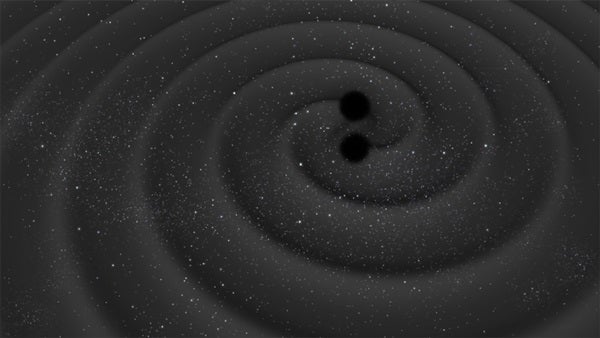The discovery was the first direct observation of gravitational waves predicted by Albert Einstein a century ago.
Two days after the detection, the LIGO team alerted a number of ground- and space-based astronomical facilities to look for a possible counterpart to the source of gravitational waves. The nature of the source was unclear at the time, and it was hoped that follow-up observations across the electromagnetic spectrum might provide valuable information about the culprit.
Gravitational waves are released when massive bodies are accelerated, and strong emission should occur when dense stellar remnants such as neutron stars or black holes spiral towards each other before coalescing.
Models predict that the merging of two stellar-mass black holes would not produce light at any wavelength, but if one or two neutron stars were involved in the process, then a characteristic signature should be observable across the electromagnetic spectrum.
Another possible source of gravitational waves would be an asymmetric supernova explosion, also known to emit light over a range of wavelengths.
It was not possible to pinpoint the LIGO source — its position could only be narrowed down to a long strip across the sky.
Observatories searched their archives in case data had been serendipitously collected anywhere along this strip around the time of the gravitational wave detection. They were also asked to point their telescopes to the same region in search for any possible “afterglow” emission.
INTEGRAL is sensitive to transient sources of high-energy emission over the whole sky, and thus a team of scientists searched through its data, seeking signs of a sudden burst of hard X-rays or gamma rays that might have been recorded at the same time as the gravitational waves were detected.
“We searched through all the available INTEGRAL data, but did not find any indication of high-energy emission associated with the LIGO detection,” said Volodymyr Savchenko of the François Arago Center in Paris, France.
The team analyzed data from the Anti-Coincidence Shield on INTEGRAL’s SPI instrument. The shield helps to screen out radiation and particles coming from directions other than that where the instrument is pointing, as well as to detect transient high-energy sources across the whole sky.
The team also looked at data from INTEGRAL’s IBIS instrument, although at the time it was not pointing at the strip where the source of gravitational waves was thought to be located.
“The source detected by LIGO released a huge amount of energy in gravitational waves, and the limits set by the INTEGRAL data on a possible simultaneous emission of gamma rays are one million times lower than that,” said Carlo Ferrigno from the INTEGRAL Science Data Center at the University of Geneva, Switzerland.
Subsequent analysis of the LIGO data has shown that the gravitational waves were produced by a pair of coalescing black holes, each with a mass roughly 30 times that of our Sun, located about 1.3 billion light-years away. Scientists do not expect to see any significant emission of light at any wavelength from such events, and thus INTEGRAL’s null detection is consistent with this scenario.
Similarly, nothing was seen by the great majority of the other astronomical facilities making observations from radio and infrared to optical and X-ray wavelengths.
The only exception was the Gamma-Ray Burst Monitor on NASA’s Fermi Gamma-Ray Space Telescope, which observed what appears to be a sudden burst of gamma rays about 0.4 seconds after the gravitational waves were detected. The burst lasted about one second and came from a region of the sky that overlaps with the strip identified by LIGO.
This detection sparked a bounty of theoretical investigations, proposing possible scenarios in which two merging black holes of stellar mass could indeed have released gamma rays along with the gravitational waves.
However, if this gamma-ray flare had had a cosmic origin, either linked to the LIGO gravitational wave source or to any other astrophysical phenomenon in the universe, it should have been detected by INTEGRAL as well. The absence of any such detection by both instruments on INTEGRAL suggests that the measurement from Fermi could be unrelated to the gravitational wave detection.
“This result highlights the importance of synergies between scientists and observing facilities worldwide in the quest for as many cosmic messengers as possible, from the recently-detected gravitational waves to particles and light across the spectrum,” said Erik Kuulkers from the European Space Agency (ESA).
This will become even more important when it becomes possible to observe gravitational waves from space. This has been identified as the goal for the L3 mission in ESA’s Cosmic Vision program, and the technology for building it is currently being tested in space by ESA’s LISA Pathfinder mission.
Such an observatory will be capable of detecting gravitational waves from the merging of supermassive black holes in the centers of galaxies for months prior to the final coalescence, making it possible to locate the source much more accurately and thus provide astronomical observatories with a place and a time to look out for associated electromagnetic emission.
“We are looking forward to further collaborations and discoveries in the newly-inaugurated era of gravitational astronomy,” said Erik.










